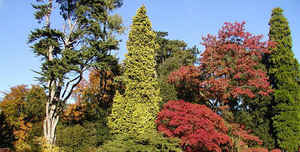Washington State Tree
Western Hemlock

(Pinaceae Tsuga heterophylla)
Adopted in 1947.
In 1946, an Oregon newspaper teased Washington for not having a state tree. The Portland Oregonian picked out the western hemlock, but Washington newspapers decided to choose their own and selected the popular western red cedar.
State Representative George Adams of Mason County pleaded with the Legislature to adopt the western hemlock. The western hemlock, (Pinaceae Tsuga heterophylla,) he said, would become "the backbone of this state's forest industry." Adams' bill passed the Legislature and was signed into law in 1947.
A large evergreen coniferous tree native to the west coast of North America, the western hemlock tree is the largest species of hemlock (growing an average of 50 - 70 meters tall, and sometimes to 78 meters) with a trunk diameter of up to 2.7 meters. The western hemlock lives a long life (trees over 1200 years old are known). Washington's abundant evergreen forests are the basis for its unofficial nickname: The Evergreen State.
Washington State Tree: Western Hemlock

Western hemlock (Tsuga heterophylla), also called Pacific hemlock and west coast hemlock, thrives in humid areas of the Pacific coast and northern Rocky Mountains. Its potential for management as an efficient producer of fiber has long been recognized. It is an important browse species for deer and elk. Western hemlock provides an important part of the esthetic background for eight national parks-four each in the United States and Canada. It is a pioneer on many sites, yet it is commonly the climax dominant. Although western hemlock grows like a weed, its versatility and potential for management make it the "Cinderella of the Northwest."
Identification of Western Hemlock

Tsuga heterophylla, the western hemlock, is a species of hemlock native to the west coast of North America.
Tsuga heterophylla is an integral component of Pacific Northwest forests west of the Coast Ranges, where it is a climax species. It is also an important timber tree throughout the region, along with many of its large coniferous associates.
- Leaf: Leaves single, linear, and spirally arranged (but somewhat 2-ranked); short (1/4 to 3/4 inches long), flat, and have two distinctly different sizes that alternate on the twig; yellow-green to green above with two white bands below. Leaves have rounded tips and short, but distinct, petioles.
- Flower: Monoecious; male cones are tiny, yellow, and occur axillary on previous year's growth; female cones are tiny, purple, and terminal.
- Fruit: Small, woody, egg-shaped cones (about 1 inch long) with numerous thin, imbricate scales; pendent, sessile, and terminal; reddish-brown; mature in one season, abundant.
- Twig: Slender, flexible, and minutely pubescent, roughened by diagonally-raised and rounded leaf scars.
- Bark: Young bark is thin, superficially scaly, and brown to black. On mature trees bark is thin (about 1 inch) with flattened ridges. Inner bark is dark red streaked with purple.
- Form: A large evergreen conifer that reaches 200 feet tall and 4 feet in diameter, mature trees have a pyramidal crown and lacy foliage that droops at the terminal ends.
Washington Law
The law designating the western hemlock as the official Wasshington state tree is found in the Revised Code of Washington, Title 1, Chapter 1.20, Section 1.20.020.
Chapter 1.20 RCW
Title 1 GENERAL PROVISIONS
RCW 1.20.020
State tree.
That certain evergreen tree known and described as the western hemlock (Tsuga heterophylla) is hereby designated as the official tree of the state
of Washington.
[1947 c 191 § 1; Rem. Supp. 1947 § 10964-120.]
Taxonomic Hierarchy: Western Hemlock
Kingdom: Plantae - Plants
Subkingdom: Tracheobionta - Vascular plants
Superdivision: Spermatophyta - Seed plants
Division: Coniferophyta - Conifers
Class: Pinopsida
Order: Pinales
Family: Pinaceae - Pine family
Genus: Tsuga Carrière - hemlock
Species: Tsuga heterophylla (Raf.) Sarg. - western hemlock








